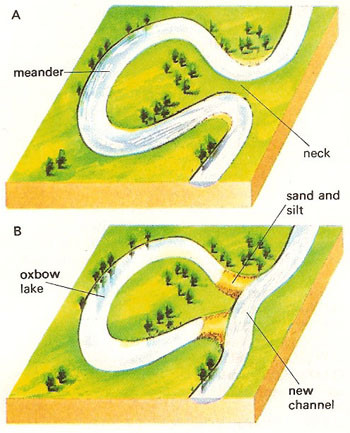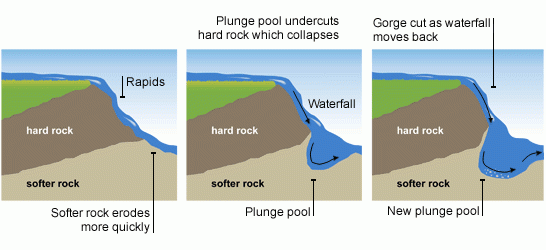River Landforms
Meanders and Ox-bow lakes
Meanders are bends in a rivers course. Water flowing around a meander moves fastest on the outside of the bend leading to erosion and the formation of a steep river cliff.
On the inside of the bend, water slows down leading to the deposition of sediment. This forms a gently-sloping slip off slope in the shallow water.
Lateral erosion by meanders leads the widening of the valley floor (floodplain). Meanders often migrate downstream and become wider and larger over time. Where there are well developed meanders, a river may take a short-cut across a narrow meander neck in times of flood and this leads to the creation of sections of abandoned river called ox-bow lakes. Over time, the ox-bow lakes dry up and leave just a meander scar.

Flood plains
A flood plain is the wide, flat area of land on either side of the river in its middle and lower course. A flood plain forms through both erosion and deposition. When material is deposited on the slip off slope of a meander it gradually builds up over time. When a river overflows its banks, water pours on to the floodplain and as it drains away fine material (alluvium) is deposited.
Levees
Levees are natural embankments of silt along the banks of a river, which are often several metres higher than the flood plain.
Deltas
A delta is a flat area of sand and silt built into the sea. When a river enters the sea carrying large volumes of fine material, the velocity slows and causes the load to be deposited in layers. Over time, the deposited material forms small islands separated by river channels called distributaries.
Waterfalls
A waterfall is a steep drop in the course of a river. They form when a band of hard resistant rock (cap rock) lies over softer, less resistant rock.
The softer rock is quickly eroded by hydraulic action and abrasion, causing the harder rock to be undercut.
The hard rock overhangs until it can no longer carry its own weight.
The overhang collapses and then breaks up in the water below.
The great power of the water at the base of the waterfall causes a plunge pool to form.
The bed of the river below the waterfall contains boulders eroded by splash back from behind the waterfall.

Gorges
Over time the process above is frequently repeated and eventually a steep-sided gorge forms as the waterfall retreats up stream.
